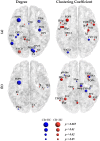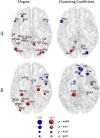Altered brain structural and functional connectivity in cannabis users
- PMID: 37037859
- PMCID: PMC10086048
- DOI: 10.1038/s41598-023-32521-8
Altered brain structural and functional connectivity in cannabis users
Abstract
Cannabis is one of the most used and commodified illicit substances worldwide, especially among young adults. The neurobiology mechanism of cannabis is yet to be identified particularly in youth. The purpose of this study was to concurrently measure alterations in brain structural and functional connectivity in cannabis users using resting-state functional magnetic resonance images (rs-fMRI) and diffusion-weighted images (DWI) from a group of 73 cannabis users (age 22-36, 19 female) in comparison with 73 healthy controls (age 22-36, 14 female) from Human Connectome Project (HCP). Several significant differences were observed in local structural/functional network measures (e.g. degree and clustering coefficient), being prominent in the insular and frontal opercular cortex and lateral/medial temporal cortex. The rich-club organization of structural networks revealed a normal trend, distributed within bilateral frontal, temporal and occipital regions. However, minor differences were found between the two groups in the superior and inferior temporal gyri. Functional rich-club nodes were mostly located within parietal and posterior areas, with minor differences between the groups found mainly in the centro-temporal and parietal regions. Regional network measures of structural/functional networks were associated with times used cannabis (TUC) in several regions. Although the structural/functional network in both groups showed small-world property, no differences between cannabis users and healthy controls were found regarding the global network measures, showing no association with cannabis use. After FDR correction, all of the significant associations between network measures and TUC were found to be insignificant, except for the association between degree and TUC within the presubiculum region. To recap, our findings revealed alterations in local topological properties of structural and functional networks in cannabis users, although their global brain network organization remained intact.
© 2023. The Author(s).
Conflict of interest statement
The authors declare no competing interests.
Figures




References
Publication types
MeSH terms
Grants and funding
LinkOut - more resources
Full Text Sources
Miscellaneous

